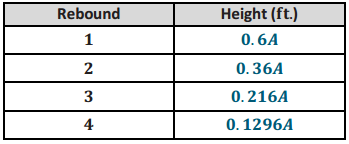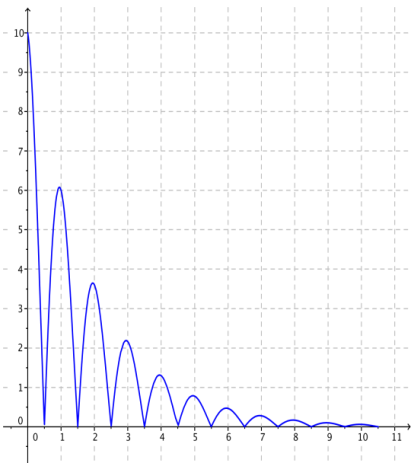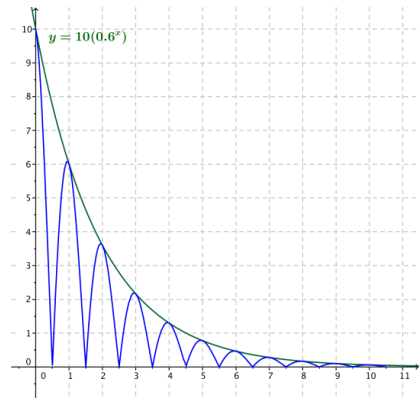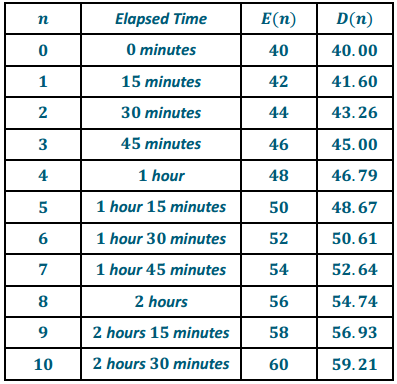Engage NY Eureka Math Algebra 2 Module 3 Lesson 25 Answer Key
Eureka Math Algebra 2 Module 3 Lesson 25 Opening Exercise Answer Key
Opening Exercise:
Suppose a ball is dropped from an initial height h0 and that each time it rebounds, its new height is 60% of its previous height.
a. What are the first four rebound heights h1, h2, h3, and h4 after being dropped from a height of h0 = 10 ft.?
Answer:
The rebound heights are h1 = 6 ft., h2 = 3.6 ft., h3 = 2.16 ft., and h4 = 1.296 ft.
b. Suppose the initial height is A ft. What are the first four rebound heights? Fill in the following table:

Answer:

c. How is each term in the sequence related to the one that came before it?
Answer:
Each term is 0.6 times the previous term.
d. Suppose the initial height is A ft. and that each rebound, rather than being 60% of the previous height, is r times the previous height, where 0 < r < 1. What are the first four rebound heights? What is the nth rebound height?
Answer:
The rebound heights are h1 = Ar ft, h2 = Ar2 ft,, h3 = Ar3 ft. and h4 = Ar4 ft. The nth rebound height is hn = ft.
e. What kind of sequence is the sequence of rebound heights?
Answer:
The sequence of rebounds is geometric (geometrically decreasing).
f. Suppose that we define a function f with domain the positive integers so that f(1) is the first rebound height, f(2) is the second rebound height, and continuing so that f(k) is the kth rebound height for positive integers kth. What type of function would you expect f to be?
Answer:
Since each bounce has a rebound height of r times the previous height, the function f should be exponentially decreasing.
g. On the coordinate plane below, sketch the height of the bouncing ball when A = 10 and r = 0.60, assuming that the highest points occur at x = 1, 2, 3, 4,…….

Answer:

h. Does the exponential function f(x) = 10(0.60)x for real numbers x model the height of the bouncing ball? Explain how you know.
Answer:

No. Exponentialfunctions do not have the same behavior as a bouncing ball. The graph off is the smooth curve that connects the points at the “top” of the rebounds, as shown in the graph at right.
i. What does the function f(n) = 10(0.60)n for integers n ≥ 0 model?
Answer:
The exponential function f(n) = 10(0.60)n models the height of the rebounds for integer values of n.
Eureka Math Algebra 2 Module 3 Lesson 25 Exercise Answer Key
Exercises:
Exercise 1.
Jane works for a video game development company that pays her a starting salary of $100 per day, and each day she works she earns $100 more than the day before.
a. How much does she earn on day 5?
Answer:
On day 5, she earns $500.
b. If you were to graph the growth of her salary for the first 10 days she worked, what would the graph look like?
Answer:
The graph would be a set of points lying on a straight line.
c. What kind of sequence is the sequence of Jane’s earnings each day?
Answer:
The sequence of her earnings is arithmetic (that is, the sequence is arithmetically increasing).
Exercise 2.
A laboratory culture begins with 1,000 bacteria at the beginning of the experiment, which we denote by time 0 hours. By time 2 hours, there are 2,890 bacteria.
a. If the number of bacteria is increasing by a common factor each hour, how many bacteria are there at time 1 hour? At time 3 hours?
Answer:
If P0 is the original population, the first three terms of the geometric sequence are P0, P0r, and P0,r2. In this case, P0, = 1000 and P2, = P0r2 = 2890, so r2 = 2.89 and r = 1.7. Therefore, P1, = P0r = 1700 and P3 = P0r3 = 2890 . 1.7 = 4913.
b. Find the explicit formula for term Pn of the sequence in this case.
Answer:
Pn = P0rn = 1000(1.7)n.
c. How would you find term Pn + 1 if you know term Pn? Write a recursive formula for Pn + 1 in terms of Pn.
Answer:
You would multiply the nth term by r, which in this case is 1.7. We have Pn + 1 = 1.7 Pn.
d. If P0 is the initial population, the growth of the population Pn at time n hours can be modeled by the sequence Pn = P(n), where P is an exponential function with the following form:
P(n) = p0 2kn where k > 0. Find the value of k and write the function P in this form. Approximate k to four decimal places.
Answer:
We know that P(n) = 1000(1.7)n and 1.7 = 2log2(1.7) with k = log2(1.7) = \(\frac{\log (1.7)}{\log (2)}\) ≈ 0.7655.
Thus, we can express P in the form: P(n) = 1000(20.7655n).
e. Use the function in part (d) to determine the value of t when the population of bacteria has doubled.
Answer:
We need to solve 2000 = 1000(20.7655t), which happens when the exponent is 1.
0.7655t = 1
t = \(\frac{1}{0.7655}\)
t ≈ 1.306
This population doubles in roughly 1.306 hours, which is about 1 hour and 18 minutes.
f. If P0 is the initial population, the growth of the population P at time t can be expressed in the following
form: P(n) = P0ekn, where k > 0. Find the value of k, and write the function P in this form. Approximate k to four decimal places.
Answer:
Substituting in the formula for t = 2, we get 2890 = 1000e2k. Solving for k, we get k = ln(1.7) ≈ 0.5306. Thus, we can express P in the form: P(t) = 1000(eo.53o6t).
g. Use the formula in part (d) to determine the value of t when the population of bacteria has doubled.
Answer:
Substituting in the formula with k = 0.5306, we get 2000 = 1000e0.5306t. Solving for t, we get
t = \(\frac{\ln (2)}{0.5306}\) ≈ 1.306, which is the same value we found in part (e).
Exercise 3.
The first term a0 of a geometric sequence is -5, and the common ratio r is -2.
a. What are the terms a0, a1, and a2?
Answer:
a0 = -5
a1 = 10
a2 = -20
b. Find a recursive formula for this sequence.
Answer:
The recursive formulais an + 1 = -2an, with a0 = -5.
c. Find an explicit formula for this sequence.
Answer:
The explicit formula is an = -5(-2)n, for n ≥ 0.
d. What is term a9?
Answer:
Using the explicit formula, we find: a9 = (-5) (-2)9 = 2560.
e. What is term a10?
Answer:
One solution is to use the explicit formula: a10 = (-5) . (-2)10 = -5120.
Another solution is to use the recursive formula: a10 = a9 . (-2) = -5120.
Exercise 4.
Term a4 of a geometric sequence is 5.8564, and term a5 is -6.44204.
a. What is the common ratio r?
Answer:
We have r = \(\frac{-6.44204}{5.8564}\) = -1.1. The common ratio is -1.1.
b. What is term a0?
Answer:
From the definition of a geometric sequence, a4 = a0r4 = 5.8564, so a0 = \(\frac{5.8564}{(-1.1)^{4}}=\frac{5.8564}{1.4641}\) = 4.
c. Find a recursive formula for this sequence.
Answer:
The recursive formulais an + 1 = -1. 1(an) with a0 = 4.
d. Find an explicit formula for this sequence.
Answer:
The explicit formulais an = 4(1.1)n, for n ≥ 0.
Exercise 5.
The recursive formula for a geometric sequence is an + 1 = 3.92(an) with a0 = 4.05. Find an explicit formula for this sequence.
Answer:
The common ratio is 3.92, and the initial value is 4.05, so the explicit formula is an = 4.05(3.92)n for n ≥ 0.
Exercise 6.
The explicit formula for a geometric sequence is an = 147(2.1)3n. Find a recursive formula for this sequence.
Answer:
First, we rewrite the sequence as an = 147(2.13)n = 147(9.261)n. We then see that the common ratio is 9.261, and the initial value is 147, so the recursive formula is an + 1 = (9.261)an with a0 = 147.
Eureka Math Algebra 2 Module 3 Lesson 25 Problem Set Answer Key
Question 1.
Convert the following recursive formulas for sequences to explicit formulas.
a. an + 1 = 4.2 + an with a0 = 12
Answer:
an = 12 + 4 . 2n for n ≥ 0.
b. an + 1 = 4. 2an with a0 = 12
Answer:
an = 12(4.2)n for n ≥ 0.
c. an + 1 = √5an with a0 = 2
Answer:
an = 2(√5)n for n ≥ 0
d. an + 1 = √5 + an with 0 = 2
Answer:
an = 2 + n√5 for n ≥ 0
e. an + 1 = πan with a0 = π
Answer:
an = π(π)n = πn + 1 for n ≥ 0.
Question 2.
Convert the following explicit formulas for sequences to recursive formulas.
a. an = \(\frac{1}{5}\)(3n)for n ≥ 0
Answer:
an + 1 = 3an with a0 = \(\frac{1}{5}\)
b. an = 16 – 2n for n ≥ 0
Answer:
an + 1 = an – 2 with a0 = 16
c. an = 16(\(\frac{1}{2}\))n for n ≥ 0
Answer:
an + 1= \(\frac{1}{2}\)an with a0 = 16
d. an = 71 – \(\frac{6}{7}\)n for n ≥ 0
Answer:
an + 1 = an – \(\frac{6}{7}\) with a0 = 71
e. an = 190(1.03)n for n ≥ 0
Answer:
an + 1 = 1.03an with a0 = 190
Question 3.
If a geometric sequence has a1 = 256 and a8 = 512, find the exact value of the common ratio r.
Answer:
The recursive formulais an + 1 = an . r, so we have
a8 = a7(r)
= a6(r2)
= a5(r3)
.
.
= a1(r7)
512 = 256(r7)
2 = r7
r = \(\sqrt[7]{2}\)
Question 4.
If a geometric sequence has a2 = 495 and a6 = 311, approximate the value of the common ratio r to four decimal places.
Answer:
The recursi ve formulais n + 1 = an . r, so we have
a6 = a5(r)
= a4(r2)
= a3(r3)
= a2(r4)
311 = 495(r4)
r4 = \(\frac{311}{495}\)
r = \(\sqrt[4]{\frac{311}{495}}\) ≈ 0.8903
Question 5.
Find the difference between the terms a10 of an arithmetic sequence and a geometric sequence, both of which begin at term a0 and have a2 = 4 and a4 = 12.
Answer:
Arithmetic: The explicit formula has the form an = a0 + nd, so a2 = a0 + 2d and a4 = a0 + 4d. Then a4 – a2 = 12 – 4 = 8 and a4 – a2 = (a0 + 4d) – (a0 + 2d), so that 8 = 2d and d = 4, we know that a0 = a2 – 2d = 4 – 8 = -4. So, the explicit formula for thos airthmetic sequence is an = -4 + 4n. we then know that a10 = -4 + 40 = 36
Geometric: The explicit formula has the form an = a0(rn), so a2 = a0(r2) and a4 = a0(r4), so \(\frac{a_{4}}{a_{2}}\)r2 and \(\frac{a_{4}}{a_{2}}=\frac{12}{4}\) = 3. Thus, r2 = 3, so r = ±√3. Since r2 = 3, we have a2 = 4 = a0(r2), so that a0 = \(\frac{4}{3}\). Then the a10 = \(\frac{4}{3}\)(±√3)<sup>10</sup> = \(\frac{4}{3}\)(35) = 4(34) = 324.
Thus, the difference between the terms a10 of these two sequence is 324 – 36 = 288.
Question 6.
Given the geometric sequence defined by the following values of a0 and r, find the value of n so that an has the specified value.
a. a0 = 64, r = \(\frac{1}{2}\), an = 2
Answer:
The explicit formula for this geometric sequence is an = 64(\(\frac{1}{2}\))n and an = 2.
2 = 64(\(\frac{1}{2}\))n
\(\frac{1}{32}\) = (\(\frac{1}{2}\))n
(\(\frac{1}{2}\))5 = (\(\frac{1}{2}\))n
n = 5
Thus, a5 = 2.
b. a0 = 13, r = 3, an = 85293
Answer:
The explicit formula for this geometric sequence is an = 13(3)n, and we have an = 85293
13(3)n = 85293
3n = 6561
3n = 38
n = 8
Thus a8 = 85293
c.a0 = 6.7, r = 1.9, an = 7804.8
Answer:
The explicit formula for this geometric sequence is an = 6.7(1.9)n, and we have an = 7804.8
6.7(1.9)n = 7804.8
(1.9)n = 1164.9
n log(1.9) = log(1164.9)
n = \(\frac{\log (1164.9)}{\log (1.9)}\) = 11
Thus, a11 = 7804.8
d. a0= 10958, r = 0.7, an = 25.5
Answer:
The explicit formula for this geometric sequence is an =10958(0.7)n, and we have an = 25.5
10958(0.7)n = 25.5
log(10958) + nlog(0.7) = log(25.5)
n = \(\frac{\log (25.5)-\log (10958)}{\log (0.7)}\)
n = 17
Thus, a17 = 25.5
Question 7.
Jenny planted a sunflower seedling that started out 5 cm tall, and she finds that the average daily growth is 3.5 cm.
a. Find a recursive formula for the height of the sunflower plant on day n.
Answer:
hn + 1 = 3.5 + hn with h0 = 5.
b. Find an explicit formula for the height of the sunflower plant on day n ≥ 0.
Answer:
h = 5 + 3.5n
Question 8.
Kevin modeled the height of his son (in inches) at age n years for n = 2,3, …, 8 by the sequence hn = 34 + 3.2(n – 2). Interpret the meaning of the constants 34 and 3.2 in his model.
Answer:
At age 2, Kevin’s son was 34 inches tall, and between the ages of 2 and 8 he grew at a rate of 3.2 inches per year.
Question 9.
Astrid sells art prints through an online retailer. She charges a flat rate per order for an order processing fee, sales tax, and the same price for each print. The formula for the cost of buying n prints is given by P, = 4.5 + 12.6n.
a. Interpret the number 4. 5 in the context of this problem.
Answer:
The number 4.5 represents a $4. 50 order processing fee.
b. Interpret the number 12.6 in the context of this problem.
Answer:
The number 12.6 represents the cost of each print, including the sales tax.
c. Find a recursive formula for the cost of buying n prints.
Answer:
Pn = 12.6 + Pn – 1 with P1 = 17.10
(Notice that it makes no sense to start the sequence with n = 0, since that would mean you need to pay the processing fee when you do not place an order.)
Question 10.
A bouncy ball rebounds to 90% of the height of the preceding bounce. Craig drops a bouncy ball from a height of 20 feet.
a. Write out the sequence of the heights h1, h2, h3, and h4 of the first four bounces, counting the initial height as h0 = 20.
Answer:
h1 = 18
h2 = 16.2
h3 = 14.58
h4 = 13.122
b. Write a recursive formula for the rebound height of a bouncy ball dropped from an initial height of 20 feet.
Answer:
hn + 1 = 0.9 hn with h0 = 20
c. Write an explicit formula for the rebound height of a bouncy ball dropped from an initial height of 20 feet.
Answer:
hn = 20(0.9)n; for n ≥ 0
d. How many bounces does it take until the rebound height is under 6 feet?
Answer:
20(0.9n < 6
n log(0.9) < log(6) – log(20) n > \(\frac{\log (6)-\log (20)}{\log (0.9)}\)
n > 11.42
So, it takes 12 bounces for the bouncy ball to rebound under 6 feet.
e. Extension: Find a formula for the minimum number of bounces needed for the rebound height to be under y, feet, for a real number 0 < y < 20.
Answer:
20(0.9)n < y
n log(0.9) < log(y) – log(20) n > \(\frac{\log (y)-\log (20)}{\log (0.9)}\)
Rounding this up to the next integer with the ceiling function, it takes |\(\frac{\log (y)-\log (20)}{\log (0.9)}\)| bounces for the bouncy ball to rebound under y feet.
Question 11.
Show that when a quantity a0 = A is increased by x%, its new value is a1 = A (1 + \(\frac{x}{100}\)) If this quantity is again increased by x%, what is its new value a2? If the operation is performed n times in succession, what is the final value of the quantity an?
Answer:
We know that x% of a number A is represented by \(\frac{x}{100}\)A. Thus, when a0 = A is increased by X%, the new quantity
a1 = A + \(\frac{x}{100}\)A = A(1 + \(\frac{x}{100}\))
If we increase it again by x%, we have
a2 = a1 + \(\frac{x}{100}\) a1
= (1 + \(\frac{x}{100}\))a1
= (1 + \(\frac{x}{100}\))(1 + \(\frac{x}{100}\))a0
= (1 + \(\frac{x}{100}\))2 a0
If we repeat this operation n times, we find that
an = (1 + \(\frac{x}{100}\))n a0.
Question 12.
When Eli and Daisy arrive at their cabin in the woods in the middle of winter, the interior temperature is 40°F.
a. Eli wants to turn up the thermostat by 2°F every 15 minutes. Find an explicit formula for the sequence that represents the thermostat settings using Eli’s plan.
Answer:
Let n represent the number of 15-minute increments. The function E(n) = 40 + 2n models the thermostat settings using Eli’s plan.
b. Daisy wants to turn up the thermostat by 4% every 15 minutes. Find an explicit formula for the sequence that represents the thermostat settings using Daisy’s plan.
Answer:
Let n represent the number of 15-minute increments. The function D(n) = 40(1.04)n models the thermostat settings using Daisy’s plan.
c. Which plan gets the thermostat to 60°F most quickly?
Answer:
Making a table of values, we see that Eli’s plan sets the thermostat to 60°F first.

d. Which plan gets the thermostat to 72°F most quickly?
Answer:
Continuing the table of values from part (c), we see that Daisy’s plan sets the thermostat to 72°F first.

Question 13.
In nuclear fission, one neutron splits an atom causing the release of two other neutrons, each of which splits an atom and produces the release of two more neutrons, and so on.
a. Write the first few terms of the sequence showing the numbers of atoms being split at each stage after a single atom splits. Use a0 = 1.
Answer:
a0 = 1, a1 = 2, a2 = 4, a3 = 8.
b. Find the explicit formula that represents your sequence in part (a).
Answer:
an = 2n
c. If the interval from one stage to the next is one-millionth of a second, write an expression for the number of atoms being split at the end of one second.
Answer:
At the end of one-second n = 1000000, s0 21000000 atoms are being split.
d. If the number from part (c) were written out, how many digits would it have?
Answer:
The number of digits in a number x is given by rounding up log(x) to the next largest integer; that is, by the ceiling of log(x), [log(x)]. Thus, there are [Iog(21000000)] digits.
Since log(21000000) = 1000000 log(2) ≈ 301030, there are 301030 digits in the number 21000000.
Eureka Math Algebra 2 Module 3 Lesson 25 Exit Ticket Answer Key
Question 1.
Every year, Mikhail receives a 3% raise in his annual salary. His starting annual salary was $40,000.
a. Does a geometric or arithmetic sequence best model Mikhail’s salary in year n? Explain how you know.
Answer:
Because Mikhail’s salary increases by a multiple of itself each year, a geometric sequence is an appropriate model.
b. Find a recursive formula for a sequence, S, which represents Mikhail’s salary in year n.
Answer:
Mikhail’s annual salary can be represented by the sequence Sn + 1 = 1.03 Sn. with S0 = $40,000.
Question 2.
Carmela’s annual salary in year n can be modeled by the recursive sequence Cn + 1 = 1.05 Cn where C0 = $75,000.
a. What does the number 1.05 represent in the context of this problem?
Answer:
The number 1.05 represents the growth rate of her salary with time; it indicates that she is receiving a 5% raise each year.
b. What does the number $75, 000 represent in the context of this problem?
Answer:
Carmela’s starting annual salary was $75, 000, before she earned any raises.
c. Find an explicit formula for a sequence that represents Carmela’s salary.
Answer:
Carmela’s salary can be represented by the sequence Cn = $75,000 (1.05)n.